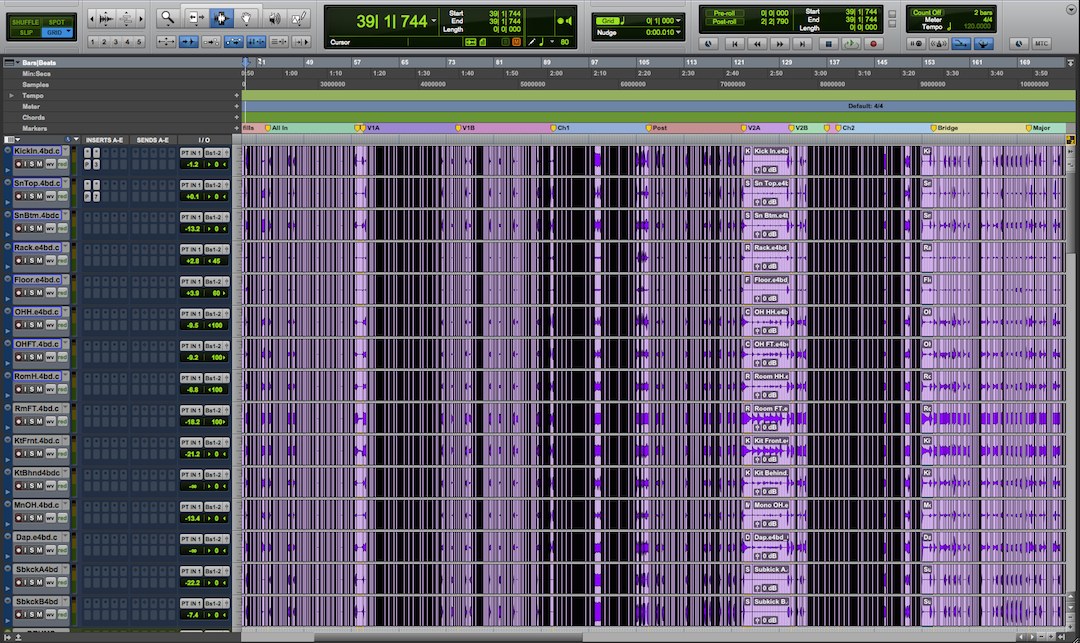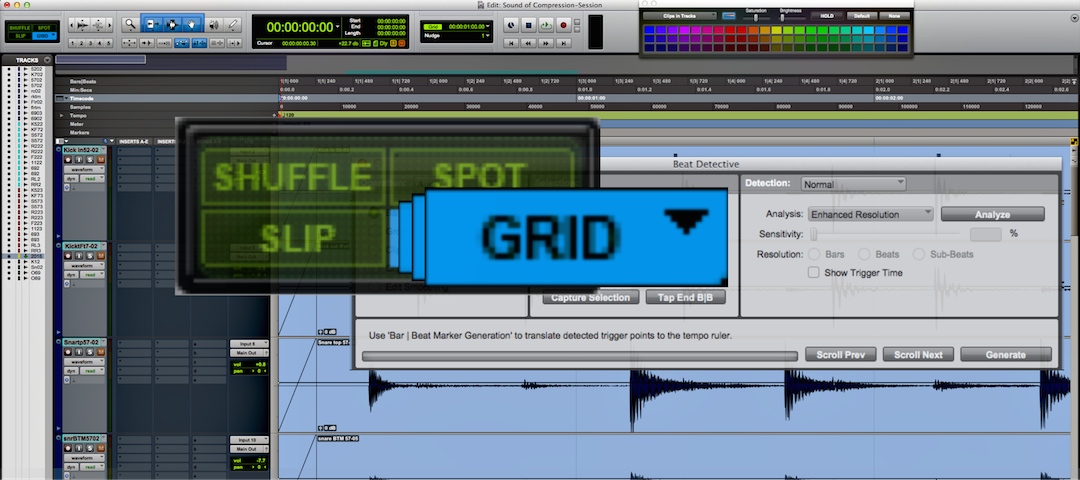Op Ed: Don't Blame Pro Tools
There’s no question that popular music has gone through some monumental changes since the 1960’s. With each passing decade, there are new technological innovations that help to form the “new sound”, and sometimes these innovations become the very identity of some musical artists.
Be it the sound of new guitar amps, the advent of multitrack recording, the widespread use of digital recording technology—and its ability to manipulate sounds after the fact—or the rise of the mp3 and the demand for portability of music for consumers.
With each new fad, the participants of the previous era will cry foul and complain about how technology has ruined music, and that things were better before.

Nowadays it is commonplace for drum performances to undergo this type of rigorous editing and quantizing.
Admittedly, I’m old and don’t entirely disagree that technology can be a contributor in creating change for the worse when it comes to music. But it’s my belief that the blame for this falls squarely on the people who choose to abuse any new technology.
It has become popular to say that “Pro Tools and Autotune have ruined music”, as if these tools did it themselves.
That’s the funny thing about technology, though: It needs us to tell it what to do. Yet we humans tend to attribute to “computer error” things that can be traced back to human error 99.9% of the time.
Computers do experience software bugs and crashes, but even those can usually be traced back to the human who wrote the code or designed the components that failed.
My biggest problem with this line of thinking is that it pushes the blame on to something inanimate, which is a cop-out.
If you want to use Pro Tools like a tape machine, you can. You don’t have to edit or use playlists to piece together a performance. You don’t have to stare at the waveform view when you’re recording either—you could close the edit window and look at a big counter display, just like you might on a tape machine.
You don’t have to lock things to the grid or even use the grid display at all. You don’t have to quantize or slip or slide your tracks. You don’t have to make sure every hit and every note are at the same volume. You can just record the music and then play it back.

Grid mode is an extremely useful feature in Pro Tools, however if edits are not done tastefully, engineers can find themselves removing the human element from performances.
People also used to love to bash digital anything for being “cold and sterile” compared to its analog counterpart.
Well, if accuracy is cold then I guess they may have a point. While early digital did not sound as accurate as it does now, it was still a good representation of what we were recording.
All of the methods that were used when recording in the analog domain are not necessarily going to give you the same results while working in digital. The inaccuracy of analog playback was often nicer sounding but was still changing the sound nonetheless; it sounded good but it was not necessarily accurate.
Because analog components and the tape itself would wear out due to excessive use, sounds would also change over time. This was a big consideration that had to be accounted for when tracking.
Maybe you used a brighter mic on the guitars so they would still cut through when it’s time to mix? Maybe you used EQ on the way in so the tape could soften that high frequency boost you added on the drum overheads? Maybe you compressed the bass a little harder to get some good average level without saturating the tape with too much low frequency information?
All of these approaches that were valid when working with analog tape are not necessary with digital recording. First of all, digital is very linear, meaning that it sounds the same from top to bottom (with some weirdness in the quieter levels, though that has improved too). If you record a signal at -26dB and another at -6dB, they both sound the same once you account for the level difference.
Digital doesn’t soften the high end the way tape does, so what you put in is what you get back. There’s no added harmonic distortion or compression either. If you want that, you have to do it yourself. Digital also sounds the same from the first playback to the last.
As far as editing and Autotune are concerned, these processes are just new ways of trying to get the results we got in the past by doing things again and again and again. I can see the appeal when a session is not going well, however for some, taking the easy way out can be a slippery slope.
But that’s the thing: you don’t have to do this. You don’t have to take the easy way out. You can record it again. You can punch in a line on a vocal track instead of tuning it. You can pretend that there’s no way to keep 10 takes of something so you can piece it together later.
You can motivate the artist to do something until it’s right and convince them to revel in the fact that the recording is representative of the way they sound in real life. These are all choices that we make when we set out to record things.
I am more of the belief that using technology to save something that was exceptional otherwise is a good way to embrace it, while still maintaining the integrity and the intent of the artist and their music.
In a way, all recordings are dishonest anyway (even the live to 2-track ones) because there are microphones, EQ, effects and mixing involved.
Even a simple mono mic in a room doesn’t sound exactly like what we would hear if we were there at the time. Our brains make all kinds of adjustments to what our ears are hearing in real time, and mics (which are brainless) do not possess this ability.
Besides, the goal of recorded music is to allow the listener to be immersed in the musical experience that the artist presents. This often requires the smoke and mirrors of the recording studio to make it compelling and engaging.
Overworking something through digital means may be just what some artists want and what their audience is expecting. If this is the case, more power to ‘em. However, to suggest that it’s the tools that are at fault is just wrong.
Computers and digital processors only do what we tell them. If you don’t have the restraint to leave something as it is, don’t blame the software manufacturers!
Mike Major is a Mixer/Producer/Recording and Mastering engineer from Dunedin, FL.
He has worked with At The Drive-In, Coheed and Cambria, Sparta, Gone is Gone, As Tall as Lions, and hundreds of other artists over the last 30 years.
Major is the author of the book “Recording Drums: The Complete Guide” and is the creator of the video series “The Method to the Mix”.







rts
October 18, 2016 at 2:36 pm (8 years ago)At the end of the day, it’s the job of the engineer to do what his clients tell him/her to do. If they want it to be autotuned, you autotune it. If they want a shitty synth orchestra instead of good sounding samples, you give it to them. That’s not the engineer’s fault, nor is it the tools’ fault. Maybe you can sway the artist one way or another, depending on your working relationship, but most of the time it’s just not your decision.
Mikey Canzonetta
October 25, 2016 at 6:11 am (8 years ago)back when we used tape, we had budgets that would cover months and months and months of recording. when a singer stepped into the booth they knew exactly what they were doing. today budgets are 1/100th of what they used to be and we’re expected to have 10 songs done in 30 days. when a vocalist steps into the booth now days, they barely have a clue of which side of the mic to “sing” into. Lets talk about the real issue here….
bobo65
November 3, 2016 at 8:26 am (8 years ago)Back in the ’60s we were expected to complete ten songs in a couple days! People who couldn’t accomplish that couldn’t get the financial backing required to record. The pressure was intense. As happy as we were to be relived of it, I think performers having that capability was a lot of what made so many great records in the ’50s-’70s. What we weren’t doing was overdubbing everything. Modern audio over Ethernet technology makes recording live ensembles affordable for the first time. Every single show and rehearsal can now be recorded and streamed or broadcast. That WILL improve recorded music dramatically thanks to technology.
James T. McGuiness
October 25, 2016 at 3:00 pm (8 years ago)“..digital is very linear….” Aaarrrgghh, sacrilege.
caseyholford
October 27, 2016 at 4:33 pm (8 years ago)Lol
Danwriter
October 27, 2016 at 5:20 pm (8 years ago)You say, “I’m old.” What that really means is you’ve had the opportunity to experience recording culture as it has evolved. Someone who’s been recording for 30 or more years looks at digital recording through a very different lens than someone for whom it’s all they’ve ever known, and who experience analog mainly by reading Classic Tracks, which is like AARP for pro audio. (And yeah, I wrote a lot of those.)
But more importantly, you overlook what I think is the real downside of digital music production: virtually unlimited tracks. The need to make artistic and technical decisons as the production progresses is gone, and with it a crucial part of the creative process. Leaving 60 or 70 or more tracks of “maybe” for the mix stage has distorted the very DNA of music production. The real estate limits of recording to tape imposed a kind of creative discipline on music that’s largely lacking today.